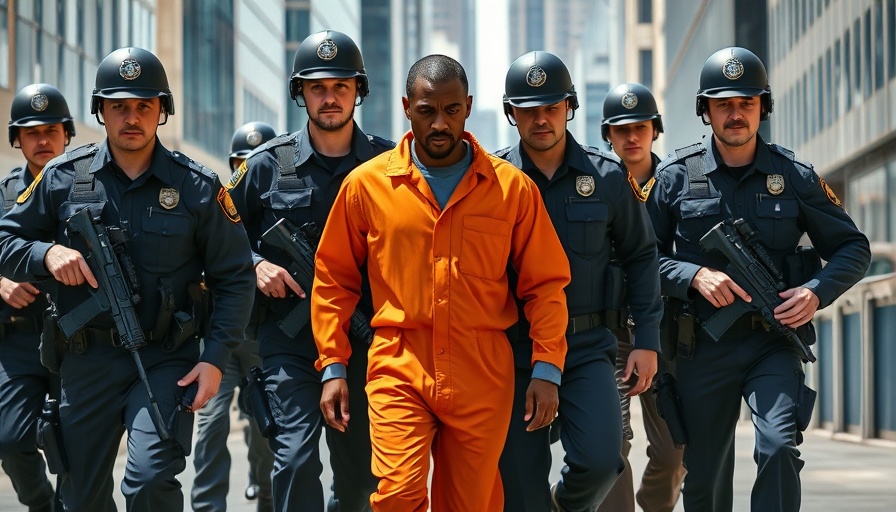
Understanding the Terror Charge: A Wake-Up Call for Executives
In a chilling twist of events, the murder of UnitedHealthcare CEO Brian Thompson has led to serious convictions within the healthcare industry, as New York prosecutors label shooter Luigi Mangione as a terrorist. The aftermath of Thompson's assassination on a busy Midtown Manhattan sidewalk has shaken the very foundation of how health insurance executives perceive their safety, prompting many to hire personal security following the shocking incident.
The implications of Mangione's terror charge extend beyond individual fear. According to Assistant District Attorney Joel Seidemann, the shooting was strategically aimed at undermining the entire healthcare insurance system. This marked a pivotal moment for executives, many of whom now feel the need to take unprecedented security measures—this includes reportedly 40 UnitedHealthcare executives who are now under the protection of bodyguards.
Historical Context: A Growing Culture of Violence
Unrest and violence directed at business leaders, especially in the healthcare sector, isn’t new. The increasing tensions stem partly from rising healthcare costs and public dissatisfaction with the insurance industry. As Congress grapples with healthcare reform and legislation aimed at controlling costs, incidents like Thompson’s murder shed light on the extreme levels of frustration among individuals towards corporations they believe are profiting at the expense of public health.
This case serves as a stark reminder of the tensions brewing between healthcare professionals and those affected by their policies. The notion that a CEO could be targeted for their role in an industry traditionally viewed as indispensable raises questions about the limits of dissent and the potential for violence in business.
Fear and Security: New Norms in the Corporate Landscape
The fear induced by this incident has real consequences for the corporate environment. Many UnitedHealthcare executives, feeling unsafe, have made drastic changes including altering their appearances—one executive even dyed her hair in an effort to escape potential recognition. This drastic action underlines how a single act of violence can create rippling effects through an entire organization.
Additionally, news of pro-Mangione graffiti and posters that emerged following the shooting points to a troubling reality: support for violent actions against corporate entities may be gaining traction in some circles. This reality forces organizations to confront not just external threats but the ethos of public perception surrounding their businesses.
Response and Resilience: Actions from UnitedHealthcare
In an effort to maintain a sense of security, UnitedHealthcare has taken substantial measures. From hiring plainclothes police to protect executives at their headquarters in Minnesota to discouraging employees from displaying company logos in public, the organization is navigating a new landscape of heightened threats. Healthcare professionals are further discouraged from signing denial letters publicly due to fear of retaliation—a response that shows the extent of anxiety gripping the industry.
Dr. Susan Melendez, a UHC physician, expressed concern, stating, “People are genuinely afraid. They don’t want to become the next target. Healthcare shouldn’t invoke fear; it should inspire trust.” Yet, it seems fear has now permeated through the folds of the healthcare sector, demanding a re-evaluation of workplace safety protocols and corporate policies.
Future Insights: Navigating Healthcare in a Changed World
The ramifications of this event raise pertinent questions about the evolution of workplace safety and the future of corporate culture in high-stakes industries. If corporate executives remain constantly vulnerable to acts of violence, more firms might invest in robust security solutions that extend beyond the traditional measures of workplace safety. Companies may need to start integrating more comprehensive mental health support for their employees to cope with the pressures they face both from their roles and societal expectations.
This incident could pave the way for government intervention regarding workplace violence in corporations and serious discussions about professional conduct within public discourse. As businesses get more accustomed to these realities, the trend should shift towards building not just safety, but also a more robust community where dissent does not turn to violence.
Addressing Misconceptions: It's More Than Just Business
A common misconception is that incidents like these are mere headlines, isolated within the world of corporate news. However, the reality is that these events reflect a deeper cultural malaise that challenges the societal fabric. The fear and hostility towards business leaders often stem from a perception of greed and elitism; a narrative that, once shaped, can lead to drastic outcomes.
Thus, as businesses navigate these turbulent waters, it's vital for them to cultivate trust and transparency in a landscape where their actions significantly impact public health and welfare. Reflections on character and not just business performance will be critical in steering companies towards a more beneficial path for all involved—employees and the public alike.
What You Can Do: Rethinking Business Strategy
For leaders in the healthcare and broader business sectors, this incident serves as an urgent call to action to reassess your company's approach to public engagement and crisis management. Focus on building a more resilient corporate culture that prioritizes the safety and security of all employees.
Consider employing strategies and frameworks that can mitigate perceived risks and build a supportive ecosystem where employees feel safe to express their opinions without fear of retaliation. Consulting with security experts could provide insights into enhancing executive safety while also fostering a healthy, collaborative work environment.
The events surrounding Brian Thompson's tragic killing shouldn't be ignored as just a chapter in a crime report. Instead, they should be a catalyst for change in how businesses operate, ensuring they aren’t just seen as entities for profit but as crucial pillars in a complex societal framework that demands wellbeing for all.
 Add Row
Add Row  Add
Add 




 Add Row
Add Row  Add
Add 

Write A Comment